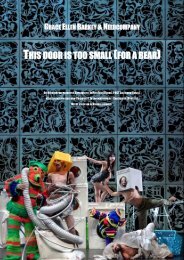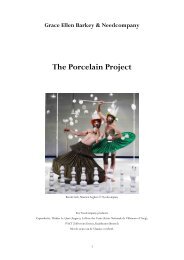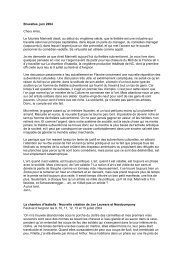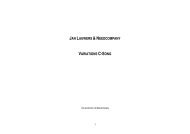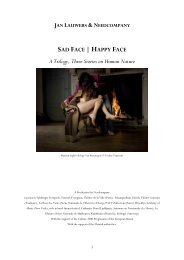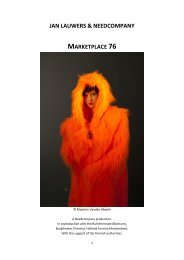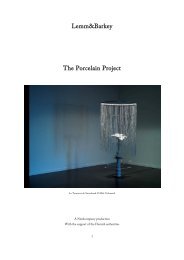THE ART OF ENTERTAINMENT - Needcompany
THE ART OF ENTERTAINMENT - Needcompany
THE ART OF ENTERTAINMENT - Needcompany
You also want an ePaper? Increase the reach of your titles
YUMPU automatically turns print PDFs into web optimized ePapers that Google loves.
and is never the same. That’s what makes the subscript important. In conventional theatre the emphasis is<br />
always on reproduction.<br />
My work is strongly influenced by performances staged in the 1970s, but then without the sometimes<br />
pernicious narcissism whose substance was often too limited. In the 1970s, early 1980s, we tried to<br />
formulate an answer to ossified conventional theatre. We threw the linear story out and introduced visual,<br />
fragmentary theatre that attached importance to the physical presence of the actors, who we preferred to<br />
call performers. Yet it was always very different from ‘performance’ as such, not least because we worked<br />
with performers. In performance art the performer is the artist himself. In the theatre the difference<br />
between the creative artist and the performing artist is very important.<br />
In the 1990s I started to explore the story, which resulted in Isabella’s Room. The production became<br />
popular because a straightforward story had never been told in that so-called metatheatre. It was as if the<br />
spectators were relieved to see that all those experiments had led somewhere.<br />
To prevent us slipping into a new form of repertoire I came up with the Needlapbs. These were one-off<br />
evenings when we tried to close the gap between artists and performers. My role was more that of a<br />
curator.<br />
The 1970s were more important than the 1980s. Several Flemish artists, like Michel Laub, were responsible<br />
for taking theatre in a new direction. Laub made highly repetitive theatre even before Wilson and Glass’s<br />
Einstein on the Beach, and it was more closely linked to the performance idea. His company was aptly<br />
named Remote Control: as the artist, Laub directed his performers from a distance. That signalled the end<br />
of the performance idea. In one of my first productions I had the performers run round the stage while a<br />
60-kilo sack of sand rotated and knocked them over. But because I was the artist and so not taking part, I<br />
began to regard it as deontologically irresponsible. The show became an ‘aestheticisation’ of the<br />
performance concept of the early 1970s.<br />
I believe that evolution was necessary. Just look at what happened to the Wiener Aktionisten. It was a<br />
dead-end. That return to the pursuit of beauty, or rather, a redefinition of beauty, was crucial. At the same<br />
time I read the writings of the artist Joseph Kosuth and other conceptualists. It seemed to me that that<br />
extreme intellectualism was not the only possible direction to go in.<br />
15




